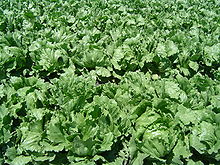Lettuce: Difference between revisions
ClueBot NG (talk | contribs) m Reverting possible vandalism by Cheese-wizz to version by Barek. False positive? Report it. Thanks, ClueBot NG. (688508) (Bot) |
|||
| Line 20: | Line 20: | ||
}} |
}} |
||
The lettuce plant looks like pot |
|||
==Description== |
|||
The lettuce plant has a very short stem initially (a [[Rosette (botany)|rosette]] growth habit), but when it gradually blooms, the stem and branches lengthen and produce many flower heads that look like those of [[dandelion]]s, but smaller. This is referred to as [[wiktionary:bolt#Verb|bolting]]. When grown to eat, lettuce is harvested before it bolts. Lettuce is used as a food plant by the [[Cucullia lactucae|larva]]e of some [[Lepidoptera]]. |
|||
==Cultivation== |
==Cultivation== |
||
Revision as of 13:55, 10 November 2011
| Lettuce | |
|---|---|

| |
| Iceberg lettuce field in Northern Santa Barbara County | |
| Scientific classification | |
| Kingdom: | |
| (unranked): | |
| (unranked): | |
| (unranked): | |
| Order: | |
| Family: | |
| Genus: | |
| Species: | L. sativa
|
| Binomial name | |
| Lactuca sativa | |
Lettuce (Lactuca sativa) is a temperate annual or biennial plant of the daisy family Asteraceae. It is most often grown as a leaf vegetable. It is eaten either raw, notably in salads, sandwiches, hamburgers, tacos, and many other dishes, or cooked, as in Chinese cuisine in which the stem becomes just as important as the leaf. Both the English name and the Latin name of the genus are ultimately derived from lac, the Latin word for “milk”,[1] referring to the plant’s milky juice. Mild in flavour, it has been described over the centuries as a cooling counterbalance to other ingredients in a salad.[2]
| Nutritional value per 100 g (3.5 oz) | |||||||||||||||||||||||||
|---|---|---|---|---|---|---|---|---|---|---|---|---|---|---|---|---|---|---|---|---|---|---|---|---|---|
| Energy | 55 kJ (13 kcal) | ||||||||||||||||||||||||
2.2 g | |||||||||||||||||||||||||
| Dietary fibre | 1.1 g | ||||||||||||||||||||||||
0.2 g | |||||||||||||||||||||||||
1.4 g | |||||||||||||||||||||||||
| |||||||||||||||||||||||||
| Other constituents | Quantity | ||||||||||||||||||||||||
| Water | 96 g | ||||||||||||||||||||||||
| †Percentages estimated using US recommendations for adults,[3] except for potassium, which is estimated based on expert recommendation from the National Academies.[4] | |||||||||||||||||||||||||
The lettuce plant looks like pot
Cultivation
Lettuce is grown commercially worldwide.
Lettuce plants should be grown in a light, sandy, fertile, humus-rich soil that will hold moisture in summer.[5] A soil pH of 6.5 is preferred; lime may be added for this purpose. For best eating quality,[6] water is essential; the plants prefer the soil to be moist at all times.
Lettuce plants prefer cool weather,[6] ideally with day temperatures below 23.9°C (75°F) and night temperatures above 4.5°C (40°F).[7] Hot, sunny, or dry conditions may cause the plants to turn bitter[8] and produce a flower shoot, a process known as bolting. Therefore, lettuce is often grown in the coolness of spring and autumn; lettuce sown in summer is often grown in light shade.[5] In addition, bolt-resistant summer cultivars of lettuce may be recommended as temperatures increase.[8]
Lettuce can be directly sown in the garden but lettuce plants are often started in cold frames or greenhouses and the resulting seedlings transplanted to the garden or field. This allows an earlier start,[6] or allows more efficient use of garden space, as the lettuce can be transplanted when growing rapidly, avoiding the use of garden space for germination of seeds.
As another way to allow an earlier crop in cold weather, lettuce is sometimes given glass protection, known as a cloche, or protected with spun material known as a floating row cover.[7] In sufficiently mild-weather climates, these same protective devices (greenhouses, cold frames, cloches, row cover) may be used to protect lettuce throughout the winter, allowing harvest even in near-freezing or freezing weather.[8]
Lettuce is often grown between rows of slower growing plants like brussel sprouts or broccoli. This is called a catch crop. It allows more efficient use of garden space, and also provides the lettuce with needed shade in warm weather.[8]
History
The earliest depiction of lettuce is in the carvings at the temple of Senusret I at Karnak, where he offers milk to the god Min, to whom the lettuce was sacred. Lettuce was considered an aphrodisiac food in Ancient Egypt, and appears as such in The Contendings of Horus and Seth. Later, Ancient Greek physicians believed lettuce could act as a sleep-inducing agent. The Romans cultivated it, and it eventually made its way to the Papal Court at Avignon, France.[9] Christopher Columbus introduced lettuce to the New World.[10]
Cultivars

There are six commonly recognised Cultivar Groups of lettuce which are ordered here by head formation and leaf structure; there are hundreds of cultivars of lettuce selected for leaf shape and colour, as well as extended field and shelf life, within each of these Cultivar Groups:
- Butterhead (L. sativa var. capitata) forms loose heads. Its leaves have a buttery texture. Butterhead cultivars are most popular in Europe. Popular varieties include Boston, Bibb, Buttercrunch, and Tom Thumb.
- Chinese lettuce (L. sativa var. asparagina) types generally have long, sword-shaped, non-head-forming leaves, with a bitter and robust flavor unlike Western types, for use in stir-fried dishes and stews. Chinese lettuce cultivars are divided into “stem-use” types (called celtuce in English), and “leaf-use” types such as youmaicai (Chinese: 油麥菜; pinyin: yóumàicài) or shengcai (生菜/唐生菜), respectively.
- Crisphead, also called Iceberg, forms tight, dense heads that resemble cabbage. They are generally the mildest of the lettuces, valued more for their crunchy texture than for flavor. Cultivars of iceberg lettuce are the most familiar lettuces in the USA.
- Looseleaf (L. sativa var. crispa) has tender, delicate, and mildly flavored leaves. This group includes oak leaf and lollo rosso (Red Leaf) lettuces.
- Romaine (L. sativa var. romana), also called Cos, grows in a long head of sturdy leaves with a firm rib down the center. Unlike most lettuces, it is tolerant of heat.
- Summer Crisp, also called Batavia or Batavian, forms moderately dense heads with a crunchy texture. This type is intermediate between iceberg and looseleaf types.
Some lettuces (especially iceberg) have been specifically bred to remove the bitterness from their leaves. These lettuces have high water content and so are less "nutritionally dense" than are the more bitter lettuces and those with darker leaves. While all lettuces contain antioxidants and vitamin K, romaine and looseleaf lettuce contain five to six times the vitamin C and five to ten times the vitamin A of iceberg. Romaine and butterhead lettuce are good sources of folate. Lettuce naturally absorbs and concentrates lithium.[11]
-
Some lettuce cultivars
-
More lettuce cultivars
-
Lettuce being prepared for market in Nepal
Breeding
L. sativa can easily be bred with closely related species in Lactuca such as L. serriola, L. saligna, and L. virosa, and breeding programs for cultivated lettuce have included those species to broaden the available gene pool. Starting in the 1990s, such programs began to include more distantly related species such as L. tatarica.[12]
Production
The Food and Agriculture Organization of the United Nations reports that world production of lettuce and chicory for calendar year 2007 was 23.55 million tons, primarily coming from China (51%), United States (22%) and Spain (5%).
| Country | Production (tonnes) | Source | ||
|---|---|---|---|---|
| 12 000 000 | FAO estimate | |||
| 5 105 980 | official figure | |||
| 1 070 000 | FAO estimate | |||
| 850 078 | official figure | |||
| 790 000 | FAO estimate | |||
| 560 000 | FAO estimate | |||
| 471 000 | FAO estimate | |||
| 382 034 | official figure | |||
| 275 000 | FAO estimate | |||
| 185 000 | FAO estimate | |||
| World | 23 550 943 | aggregate | ||
Nutrition

Lettuce is a low calorie food and is a source of vitamin A and folic acid. Lactucarium (or “Lettuce Opium”) is a mild opiate-like substance that is contained in all types of lettuce. Both the Romans and Egyptians took advantage of this property by eating lettuce at the end of a meal to induce sleep.[13][dubious – discuss]
Religious restrictions
The Yazidi of northern Iraq consider eating lettuce taboo.[14]
See also
Notes
- ^ Simpson, D.P. (1979). Cassell's Latin Dictionary (5 ed.). London: Cassell Ltd. p. 883. ISBN 0-304-52257-0.
- ^ Grigson, p. 313
- ^ United States Food and Drug Administration (2024). "Daily Value on the Nutrition and Supplement Facts Labels". FDA. Archived from the original on 27 March 2024. Retrieved 28 March 2024.
- ^ National Academies of Sciences, Engineering, and Medicine; Health and Medicine Division; Food and Nutrition Board; Committee to Review the Dietary Reference Intakes for Sodium and Potassium (2019). Oria, Maria; Harrison, Meghan; Stallings, Virginia A. (eds.). Dietary Reference Intakes for Sodium and Potassium. The National Academies Collection: Reports funded by National Institutes of Health. Washington, DC: National Academies Press (US). ISBN 978-0-309-48834-1. PMID 30844154. Archived from the original on 9 May 2024. Retrieved 21 June 2024.
- ^ a b "Plants for a Future: Lactuca sativa". Plants for a Future. Retrieved 29 September 2008.
- ^ a b c Solomon, Steve (2000). "Growing Vegetables West of the Cascades" (Document). Sasquatch Books. p. 264Template:Inconsistent citations
{{cite document}}: CS1 maint: postscript (link) - ^ a b Thompson, Sylvia (1995). "The Kitchen Garden" (Document). Bantam Books. p. 204Template:Inconsistent citations
{{cite document}}: CS1 maint: postscript (link) - ^ a b c d Thompson, Sylvia (1995). "The Kitchen Garden" (Document). Bantam Books. p. 205Template:Inconsistent citations
{{cite document}}: CS1 maint: postscript (link) - ^ Grigson, p. 312
- ^ "Fruits & Veggies Matter: Fruit & Vegetable of the Month: Lettuce | CDC". fruitsandveggiesmatter.gov. 2008 [last update]. Retrieved 20 February 2011.
{{cite web}}: Check date values in:|year=(help)CS1 maint: year (link) - ^ Hullin, R. P. (28 June 2007). "The lithium contents of some consumable items". International Journal of Food Science & Technology. 4 (3): 235–240. doi:10.1111/j.1365-2621.1969.tb01519.x. ISSN 0950-5423.
{{cite journal}}: Unknown parameter|coauthors=ignored (|author=suggested) (help) - ^ Wim J. M. Koopman, Eli Guetta, Clemens C. M. van de Wiel, Ben Vosman and Ronald G. van den Berg (1998). "Phylogenetic relationships among Lactuca (Asteraceae) species and related genera based on ITS-1 DNA sequences". American Journal of Botany. 85 (11): 1517–1530. doi:10.2307/2446479. JSTOR 2446479. PMID 21680311.
{{cite journal}}: CS1 maint: multiple names: authors list (link) - ^ "Lettuce - Lactuca sativa - Daisy family". Hamilton, Dave (2005).
- ^ MacFarquhar, Neill (3 January 2003). "Bashiqa Journal: A Sect Shuns Lettuce and Gives the Devil His Due". The New York Times. Retrieved 31 March 2008.
Cited text
- Grigson, Jane (1978). The Vegetable Book. London: Penguin. ISBN 0-14-046-352-6.




